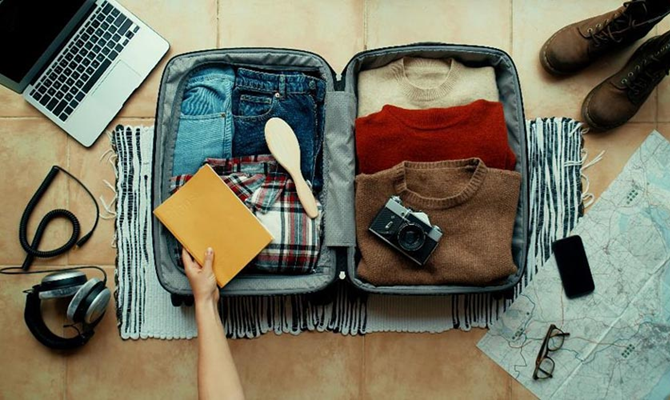In a world of ever-increasing travel, the seemingly simple act of packing a suitcase has evolved into an art form. It’s a delicate balance between necessity and desire, efficiency and comfort, and ultimately, a reflection of a well-prepared traveler. This comprehensive guide, Mastering the Art of Packing: Your Essential Guide to Putt Clothes in a Suitcase Before Going on a Trip, delves deep into the strategies, tips, and tricks that will transform your pre-travel routine from a stressful chore into a seamless and satisfying experience. Whether you’re a seasoned globetrotter or a first-time adventurer, this article, optimized for both user experience and search engine visibility, will equip you with the knowledge to pack smarter, not harder. This invaluable insight into how to put clothes in a suitcase before going on a trip ensures you embark on your journey with confidence and ease, leaving packing woes behind.
Pre-Packing Preparations: The Foundation of a Flawless Suitcase
The secret to efficient packing begins long before you even open your suitcase. This preparatory phase is crucial for ensuring you only pack what you need and avoid last-minute panic.
- Check the Weather at Your Destination: This is arguably the most critical step. Knowing the temperature, humidity, and likelihood of rain will dictate the type and quantity of clothing you need to pack. Don’t rely on assumptions; check reliable weather forecasts for the duration of your trip. For instance, “packing clothes for a warm destination” will differ significantly from “putting clothes in a suitcase for a winter getaway.”
- Understand Your Itinerary: Are you attending formal events, hiking, swimming, or simply relaxing? Your activities will directly influence your clothing choices. Create a rough daily itinerary to visualize your needs. This foresight prevents overpacking and ensures you have the appropriate attire for every occasion.
- Make a Comprehensive Packing List: This is your packing bible. Categorize items by clothing type (tops, bottoms, outerwear), toiletries, electronics, documents, and miscellaneous. A well-structured list ensures you don’t forget essentials and helps you visualize your entire wardrobe. You can find numerous printable packing lists online, or create your own tailored to your specific needs. This step is key for anyone trying to efficiently “put clothes in a suitcase.”
- Do Laundry in Advance: Ensure all the clothes you intend to pack are clean and ready to go. The last thing you want is to realize your favorite shirt is dirty just before departure. This seemingly small step can save you significant time and stress.
- Choose the Right Suitcase: The size and type of your luggage will influence how much you can pack and how easily you can transport it. Consider the length of your trip, airline baggage restrictions, and your travel style. For short trips and traveling, a carry-on might suffice, while longer journeys will necessitate a larger checked bag. The type of suitcase (hard-shell vs. soft-sided) can also impact packing strategies.
How to Put Clothes in a Suitcase Strategically
Now, for the core of the matter: the actual process of putting clothes in a suitcase. There are several popular methods, each with its own advantages. The goal is to maximize space, minimize wrinkles, and make items easily accessible.
- The Rolling Method (KonMari Style): This technique involves tightly rolling each piece of clothing, from t-shirts and jeans to dresses.
- How-to: Fold the item lengthwise, then roll it tightly from the bottom up.
- Pros: Significantly saves space, minimizes wrinkles (especially for cotton and knits), and allows you to see all your items at a glance, making it easier to “put clothes in a suitcase” efficiently.
- Cons: Can be more time-consuming initially. Best for casual wear.
- The Folding Method (Traditional): This involves neatly folding clothes into rectangular shapes and stacking them.
- How-to: Fold shirts, pants, and other items according to their natural creases.
- Pros: Good for delicate items, formal wear, and garments prone to wrinkling when rolled.
- Cons: Can take up more space than rolling, and items at the bottom of the stack can get crushed.
- The Bundling Method: This advanced technique involves wrapping smaller, wrinkle-resistant items around larger, more delicate ones.
- How-to: Start with a central item (e.g., a jacket or suit) and wrap other items around it, layer by layer, ensuring each layer is smooth.
- Pros: Excellent for minimizing wrinkles, especially for business attire.
- Cons: Can be complex to master and time-consuming.
- The Flat Layering Method: This involves laying clothes flat in the suitcase, alternating the direction of collars and hems to create a relatively even surface.
- How-to: Lay pants flat with the legs extending over the edge of the suitcase, then layer shirts, skirts, and dresses on top. Finally, fold the pant legs over.
- Pros: Good for minimizing wrinkles in formal wear.
- Cons: Less space-efficient than rolling.
Optimizing Every Nook and Cranny: Maximizing Space in Your Suitcase
Beyond the primary packing method, several clever tactics can help you squeeze out every last bit of space.
- Utilize Packing Cubes: These fabric organizers are game-changers. They compress clothes, keep categories separate, and make it incredibly easy to find what you need without rummaging through your entire suitcase. For anyone looking to “put clothes in a suitcase” with maximum organization, packing cubes are a must-have.
- Stuff Shoes: Don’t let the empty space inside your shoes go to waste. Fill them with socks, underwear, small accessories, or even rolled-up t-shirts.
- Wear Your Bulkiest Items: If you’re traveling with a heavy coat, boots, or a bulky sweater, wear them on the plane instead of packing them. This significantly frees up suitcase space.
- Roll Belts and Scarves: These items can be rolled tightly and tucked into gaps or placed inside shoe cavities.
- Use Vacuum Seal Bags (with caution): While these bags can drastically reduce the volume of soft items, they don’t reduce weight. Also, consider that you might not have access to a vacuum cleaner at your destination to re-seal them. Use sparingly for items like winter coats or extra blankets.
Strategic Placement: Where to Put What in Your Suitcase
The order in which you put clothes in a suitcase matters for weight distribution and accessibility.
- Heavy Items at the Bottom (Wheeled End): Place shoes, toiletries bags, and other heavy items at the bottom of your suitcase (the end with the wheels if it’s an upright bag). This helps distribute weight evenly and prevents the bag from toppling over.
- Rolled or Folded Clothes in the Middle: This is where the bulk of your clothing will go, arranged according to your chosen packing method.
- Delicate and Easily Wrinkled Items on Top: Place suits, dresses, and other items that you want to keep pristine on the very top, using the flat layering method or by folding them carefully.
- Essentials and Liquids in Easy-Access Pockets: Keep items you might need during transit (e.g., a light jacket, an eye mask, travel documents) in exterior pockets or the top compartment. Liquids, especially those exceeding TSA limits for carry-on, should be in checked luggage and placed in a leak-proof bag.
Beyond Clothes: Don’t Forget the Essentials
While “putting clothes in a suitcase” is the primary focus, a well-packed bag encompasses more than just garments.
- Toiletries: Always use travel-sized containers or decant your products into smaller bottles. Place them in a clear, leak-proof bag. Consider a hanging toiletry bag for convenience at your destination.
- Medications: Keep essential medications in your carry-on bag, along with a copy of your prescription if traveling internationally.
- Electronics and Chargers: Pack all chargers, adapters, and power banks. Consider a dedicated electronics organizer to keep everything tidy.
- Documents: Keep passports, visas, tickets, and booking confirmations in a secure, easily accessible place, ideally in your personal item or carry-on.
- Small Emergency Kit: Include band-aids, pain relievers, antiseptic wipes, and any personal necessities.
Post-Packing Checklist: Before You Zip It Up
Before you finally zip up your suitcase and head out the door, a quick final check can prevent headaches.
- Check Weight Limits: Weigh your bag to ensure it complies with airline restrictions, especially if you’re checking luggage. This helps avoid unexpected fees.
- Double-Check Your Packing List: A quick scan ensures you haven’t forgotten anything crucial.
- Leave Room for Souvenirs: If you plan on buying souvenirs, consider leaving a little extra space or packing a foldable duffel bag for your return journey.
- Secure All Zippers and Straps: Make sure everything is tightly closed and straps are secured to prevent snagging during transit.
Conclusion: Travel with Confidence, One Perfectly Packed Suitcase at a Time
The act of “putting clothes in a suitcase before going on a trip” is more than just a logistical exercise; it’s an investment in a smoother, more enjoyable travel experience. By adopting a methodical approach, utilizing smart packing techniques, and understanding the nuances of space optimization, you can transform the pre-trip chore into a confident stride towards your next adventure. Remember, a well-packed suitcase is a testament to a well-prepared traveler, allowing you to focus on creating unforgettable memories rather than wrestling with disarray. Happy travels!










Leave a Reply